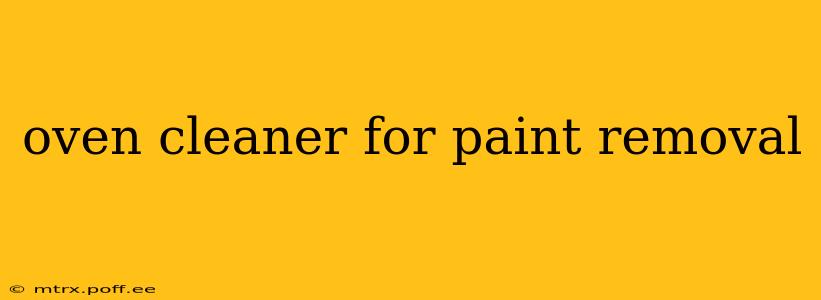Oven cleaner is a potent chemical concoction designed to dissolve baked-on grease and grime. Its aggressive nature also makes it surprisingly effective at removing paint, but it's crucial to understand the risks and precautions before attempting this method. This guide will explore the pros, cons, and essential safety measures involved in using oven cleaner for paint removal.
How Does Oven Cleaner Remove Paint?
Oven cleaners typically contain strong alkaline chemicals, often lye (sodium hydroxide). These chemicals break down the chemical bonds in paint, causing it to soften and blister. This allows for easier scraping or removal. Different types of paint will react differently, with some being more susceptible than others. Oil-based paints generally respond better than water-based latex paints.
What Types of Paint Can Be Removed with Oven Cleaner?
While oven cleaner can work on various paints, its effectiveness varies. It's generally more successful on older, oil-based paints. Water-based latex paints may require longer exposure and may not always remove completely. It's crucial to test the cleaner in an inconspicuous area before applying it broadly to assess its effectiveness on the specific paint type.
Is Oven Cleaner Safe for Paint Removal?
No, oven cleaner is not inherently safe for paint removal. The highly caustic nature of the chemicals poses several risks:
- Skin irritation and burns: Direct contact can cause severe skin irritation, burns, and chemical reactions.
- Eye damage: Oven cleaner splashes can lead to serious eye damage.
- Respiratory problems: Inhalation of fumes can irritate the lungs and respiratory system.
- Damage to the surface: While effective on paint, oven cleaner can also damage the underlying surface, particularly if left on too long or used on sensitive materials.
What Safety Precautions Should Be Taken When Using Oven Cleaner for Paint Removal?
Safety is paramount when working with oven cleaner. Always follow these precautions:
- Wear appropriate personal protective equipment (PPE): This includes gloves (preferably chemical-resistant), eye protection (goggles), and a respirator to prevent inhalation of fumes.
- Work in a well-ventilated area: Open windows and doors to ensure adequate ventilation. Consider using a fan to exhaust fumes outdoors.
- Follow the manufacturer's instructions: Carefully read and follow the instructions provided on the oven cleaner label. This includes application time, safety precautions, and disposal methods.
- Test in an inconspicuous area: Before applying to a large surface, test the cleaner on a small, hidden area to assess its impact on both the paint and the underlying material.
- Protect surrounding areas: Cover any areas you don't want to be affected by the cleaner, such as plants, furniture, or other surfaces.
- Neutralize the cleaner after use: Once the paint is removed, neutralize the cleaner with a solution of white vinegar and water before cleaning the area thoroughly.
- Dispose of the cleaner properly: Follow local regulations for disposing of hazardous waste.
What are the Alternatives to Oven Cleaner for Paint Removal?
There are safer and often more effective alternatives for paint removal, including:
- Heat guns: These tools soften the paint, making it easier to scrape off.
- Paint strippers: Chemical paint strippers are available in various formulations, offering a safer alternative to oven cleaner.
- Sandblasting: For larger projects, sandblasting can be effective but requires specialized equipment and expertise.
- Mechanical removal: Scraping, sanding, or using a power washer can remove paint, although it can be more labor-intensive.
How Long Should Oven Cleaner Sit on Paint Before Removal?
The dwell time (how long the oven cleaner sits on the paint) depends on the type of paint, the oven cleaner's strength, and the surface's material. Always refer to the manufacturer's instructions. Generally, it ranges from a few minutes to several hours. Excessive dwell time can increase the risk of damage to the underlying surface.
Can Oven Cleaner Damage the Surface Underneath the Paint?
Yes, oven cleaner can damage the underlying surface, especially wood, metal, or plastic. The caustic chemicals can etch, discolor, or corrode these materials. Therefore, it's crucial to test the cleaner in an inconspicuous area before widespread application.
In conclusion, while oven cleaner can be effective at removing paint, it's a risky solution. The potential dangers to your health and the surface being treated outweigh the benefits in most cases. Safer and often more effective alternatives are readily available. Always prioritize safety and consider the potential risks before using oven cleaner for paint removal.
